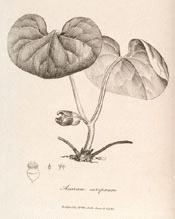
Botanical.com Home Page

|
Asarabacca
(Asarum europaeum)
Click on graphic for larger image
|
Asarabacca
Botanical: Asarum europaeum (LINN.)
Family: N.O. Aristolochiaceae
---Synonyms---Hazelwort. Wild Nard.
---Parts Used---Root and Herb.
Asarabacca is the only British species of the Birthwort family (and perhaps not indigenous). It is a curious plant consisting of a very short fleshy stem, bearing two large, dark-green, kidney-shaped evergreen leaves, and a solitary purplish-green drooping flower.
Found in woods and very rare. Flowering in May - Perennial.
The herbs belonging to this order are chiefly plants or shrubs of a tropical habitat, very abundant in South America; but rare elsewhere.
---Medicinal Action and Uses---Tonic and stimulant, sometimes acrid or aromatic. The dried and powdered leaves of Asarabacca (Asarum Europaeum) are used in the preparation of cephalic snuffs, exciting sneezing and giving relief to headache and weak eyes.
Mixed with Ribwort, this herb is used to remove mucous from the respiratory passages.
Virginian Snake-root (Aristolochia serpentaria) and other allied species are used as antidotes to the bite of venomous snakes.
The juice extracted from a South American species is said to have the power of stupefying serpents if placed in their mouths; and African species are used by Egyptian jugglers for this purpose.
The British variety is said to be found wild in Westmorland and other places in the north of England.
- Culpepper says of the European species:
- 'This herb, being drunk, not only provoketh vomiting but purgeth downward . . . both choler and phlegm. If you add to it some spikenard, with the whey of goat's milk, or honeyed water, it is made more strong; but it purgeth phlegm more manifestly than choler, and therefore doth much help pains in the hips and other parts; being boiled in whey they wonderfully help the obstructions of the liver and spleen, and are therefore profitable for the dropsy and jaundice: being steeped in wine and drank it helps those continual agues that come by the plenty of stubborn tumours; an oil made thereof by setting in the sun, with some laudanum added to it, provoketh sweating (the ridge of the back anointed therewith) and thereby driveth away the shaking fits of the ague. It will not abide any long boiling, for it loseth its chief strength thereby; nor much beating, for the finer powder doth provoke vomit and urine, and the coarser purgeth downwards. The common use hereof is to take the juice of five or seven leaves in a little drink to cause vomiting; the roots have also the same virtue, though they do not operate forcibly, they are very effectual against the biting of serpents, and therefore are put in as an ingredient both into Mithridate and Venice treacle. The leaves and root being boiled in Iye, and the head often washed therewith while it is warm, comforteth the head and brain that is ill affected by taking cold, and helpeth the memory.
- 'I shall desire ignorant people to forbear the use of the leaves- the roots purge more gently, and may prove beneficial to such as have cancers, or old putrefied ulcers, or fistulas upon their bodies, to take a dram of them in powder in a quarter of a pint of white wine in the morning. The truth is, I fancy purging and vomiting medicines as little as any man breathing doth, for they weaken nature, nor shall ever advise them to be used unless upon urgent necessity. If a physician be nature's servant, it is his duty to strengthen his mistress as much as he can and weaken her as little as may be.'
---Constituents---The root and leaves are acrid and contain a volatile oil, a bitter matter, and a substance like camphor. Asarabacca was formerly used as a purgative and emetic also to promote sneezing - but it is now rarely used, having been supplanted by safer and more certain remedies.
See:
(WILD) GINGER
(VIRGINIAN) SNAKEROOT
[Top]
Common Name Index
A MODERN HERBAL Home Page
Bear in mind "A Modern Herbal" was written with the conventional wisdom of the early 1900's. This should be taken into account as some of the information may now be considered inaccurate, or not in accordance with modern medicine.
© Copyright Protected 1995-2024 Botanical.com
|

